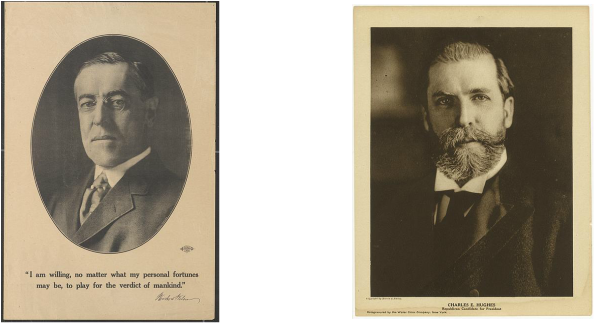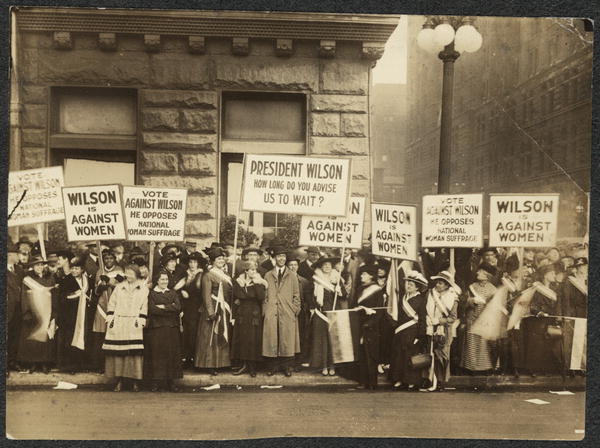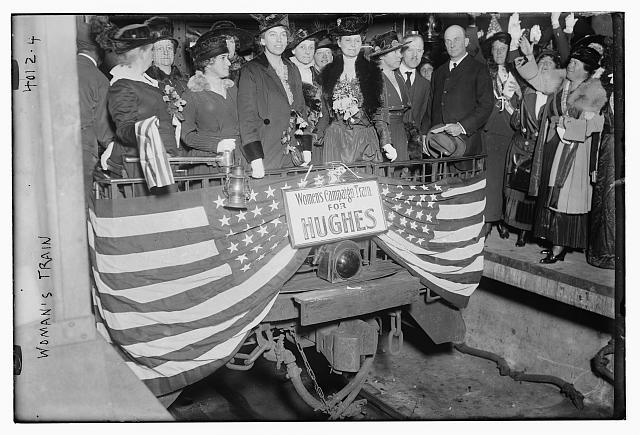And what of women? Some could legally vote, but most could not. It came down to geography. I got to thinking about this the day of the Illinois primary a few weeks ago. My eldest daughter in Chicago faced a daunting to-do list, including driving seven hours for an audition, yet she was adamant about voting before her trip. Inspired, I decided to do some time travel and examine the question based on her location, that of my other two-college-age daughters (Minnesota and Iowa), and mine (South Dakota).
In 1916, the 19th Amendment's guarantee of suffrage for women was still four years away. Both figuratively and literally, a lot of bloodshed was yet to come in suffrage skirmishes and on World War I battlefields. (The war played a significant role in advancing woman suffrage, as it was typically called.) Nevertheless, by 1916, several western states and one state east of the Mississippi allowed women to vote -- specifically, the right to vote for president, as women in some states had partial suffrage rights.
A century ago, suffragists couldn’t get behind Wilson's reelection campaign. His stance on woman suffrage was -- how shall I describe it? -- fluid. His suffrage phases encompassed the following (please permit me some leeway with the paraphrasing):
- Heck no. Women don’t need no stinking vote.
- I haven’t given it much thought; it’s not the federal government’s decision to make, but I reckon it’s okay if a state wants to allow it.
- Cripes, what is it with these women traipsing outside the White House and nattering on about suffrage? Arrest them!
- Rah! Rah! Votes for women! Congress, get your collective butts in gear NOW. Listen up -- I say it's “vitally essential” that we pass a suffrage amendment.
Anyway, in 1916, President Wilson was still firmly outside of the pro-suffrage amendment camp as he campaigned for re-election. The official party platform purported to support woman suffrage, as long as it happened on a state-by-state basis. The Republican platform said the same, albeit in more flowery language.
All I can say is that it’s a good thing women didn’t wait around for state-by-state suffrage, or some of us might still be disenfranchised today. In 1916, the quest for woman suffrage looked a lot like the proverbial tortoise and hare race – but stuck at the part where the tortoise looked to be the likely loser. By then, the battle for the ballot box was nigh on 70 years old.
The tortoises/suffragists seemed to get a boost when candidate Evans ventured beyond the official party platform and backed a federal amendment: “I think it to be most desirable that the question of woman suffrage should be settled promptly … for the entire country. My view is that the proposed amendment should be submitted and ratified and the subject removed from political discussion.” (From The New York Times, August 2, 1916.)
Wilson’s campaign slogan was “He kept us out of war” (phrased, as you notice, in the past tense, and one that remained true only until April 1917). Wilson prevailed in the general election – but barely – with a margin of less than 600,000 in the popular vote and just 23 in the Electoral College (277 to 254).
To get back to my original question: My 21-year-old daughters and I, in South Dakota, Minnesota, and Iowa, would have been voiceless on November 7, 1916. I suppose we’d have had to hope that my husband/their dad voted as we would have. One vote on behalf of four of us -- and no room for differing opinions, apparently.
My eldest, in Illinois, would have had the rare honor of voting. That's because in 1913, Illinois became the first state east of the Mississippi to allow women to vote for presidential electors.
Allow me a short digression (again). Ironically, Illinois women could vote for president in 1916 but weren’t allowed to vote for governor and some other elected offices. And, to minimize the risk of cooties, they had to use separate ballots and ballot boxes, according to author and historian Mark Sorensen. Okay, I made up the part about cooties, but I didn’t make up the part about separate ballot boxes. (Sorensen’s brief history of woman suffrage in Illinois makes for good reading.)
So, when could women vote in your home state, territory, or country? Check out this map for further info for the U.S. And how would you have voted 100 years ago?



 RSS Feed
RSS Feed